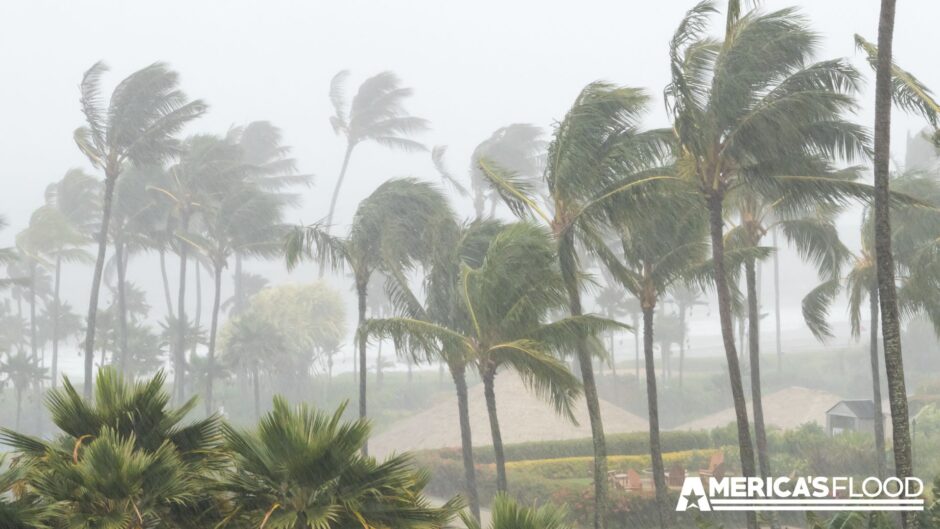6 Ways To Protect Your Home and Family During Hurricane Season
Floods are one of the most common types of natural disasters in the United States. Flooding often occurs as a result of sustained rain, snowmelt, or a hurricane/tropical storm.
While the time of year that floods are most likely to happen varies from region to region, areas prone to hurricanes are most likely to see flooding during hurricane season, which runs from June 1 to November 30.
Unfortunately, 2021 is expected to be a pretty severe hurricane season. The CSU Tropical Meteorology Project team is predicting 17 named storms this year and is estimating a 69% chance that a hurricane will make landfall in the U.S. (compared to only a 52% chance in an average year).
This makes it critical that homeowners in hurricane-prone regions take steps to prepare their house for a hurricane in the coming months. To help get you started, here’s a guide for what items you should put on your flood preparedness checklist this year.
Know Your Risk
The first item of your hurricane preparedness list is knowing the risk of flooding in your area.
While there could be flood risk in almost any region of the U.S., some areas are more prone to flooding than others.
For example, homes in low-lying areas, and/or those near bodies of water are at a higher risk of flooding.
To start, use FEMA’s website to determine the flood risk where you live. Knowing whether your home is in a flood zone can help you to determine if you should consider taking special precautions to prepare for floods.
You can also reach out to your local government for information about what the flood risk is in your neighborhood, and the flood history in your town as well.
At America’s Flood, we’re happy to help you navigate the FEMA map and understand the flood risks in your area, so don’t hesitate to reach out with any questions >
Prepare an Emergency Kit
A flood emergency could strike with little to no warning.
You may find yourself needing to evacuate your home at a moment’s notice. Or worse, you could become trapped in your home without electricity or running water in the event of a severe flood.
It’s critical that every household — regardless of whether you’re in a flood zone — has a fully stocked emergency kit or hurricane survival kit that’s easily accessible at all times.
Your kit should include essentials like a first-aid kit, non-perishable food, bottled water, a flashlight, extra batteries, an emergency radio, and a week’s worth of medicine. If you have pets, make sure that you include pet supplies in your emergency kit as well.
Prepare at least 3-5 days’ worth of supplies in a portable emergency kit that you could take with you in the event of an evacuation.
You should also try to keep an additional 2 weeks’ worth of supplies in your home. This will help ensure that you and your family have enough supplies and stay prepared for a flood disaster.
Stay Informed
Staying informed is key in keeping your home and family safe from flooding. A great place to start is enabling emergency alerts on your phone, and watch for Wireless Emergency Alerts (WEA).
WEA is a government program that sends an emergency alert to the mobile devices of users who have this feature enabled.
Only government officials can send WEA push alerts, and these alerts are the quickest way to receive information if flooding is expected in your area.
You can also sign up to receive alerts from the National Oceanic and Atmospheric Administration (NOAA) as well as local alert systems.
Signing up to receive flood alerts can help to ensure that you have time to prepare your property, and/or evacuate, in a timely manner before flooding occurs.
Have an Evacuation Plan
One of the most important things that you can do to ensure your family is ready in the event of a flood is to have an evacuation plan in place.
Take the time to sit down with your family and create a plan for what you’ll do in the event of an emergency. To ensure a quick and efficient evacuation, everyone should have a job.
Make sure you’re all in agreement on what each member of the family is responsible for in the event of a flood. This could include grabbing documents, loading the car, turning off utilities, or checking road conditions. Agree upon a set meetup place in the event of an evacuation, in case anyone gets separated from the group.
You should also have a predetermined evacuation route mapped out. You’ll need to know several routes out of your neighborhood in case there are road closures. Make sure your route avoids bridges and includes main roads that are less likely to be flooded.
Contact your local government when creating your evacuation plan, as there may already be pre-determined evacuation routes and shelters in place if you live in a flood zone.
Once you have a plan in place, practicing your evacuation plan can help to further ensure everyone in your family is on the same page and is prepared for an emergency.
Prepare Your Property for Potential Flooding
If you live in a flood zone, there are steps you can take to ensure your property is prepared for a potential flood:
1. Elevate Electrical Components
- Make sure that your furnace, water heater, electrical panel, and other electrical components are elevated.
- This can help you to avoid expensive water damage, or even electrocution, in the event of a flood.
- Talk to a professional contractor to find out where to position these items to protect them from flooding.
2. Install Check Valves
- Install check valves on your plumbing to prevent floodwater from backing up into the drains in your home.
- You can also protect your home from infiltrating floodwaters by ensuring that your basement’s walls are properly waterproofed to avoid seepage.
3. Grade Your Yard
- Have your yard graded to ensure water runs away from your home to keep water out for as long as possible.
- But In the event of a hurricane or tropical storm, you’ll likely need sandbags to keep water away from your home.
- The fact is that the slope of your yard may not be enough to keep water out during extreme weather conditions.
Invest in a Flood Insurance Policy
If you live in a flood zone, one of the most important things you can do to protect your property is to invest in flood insurance.
Most homeowners’ insurance policies don’t cover flood damage. But as little as an inch of floodwater can cause up to $25,000 in damage.
Flood insurance with America’s Flood can give you peace of mind knowing your home, rental property, and assets are protected all year long.
Contact us to learn more about flood insurance and the benefits it can provide >





